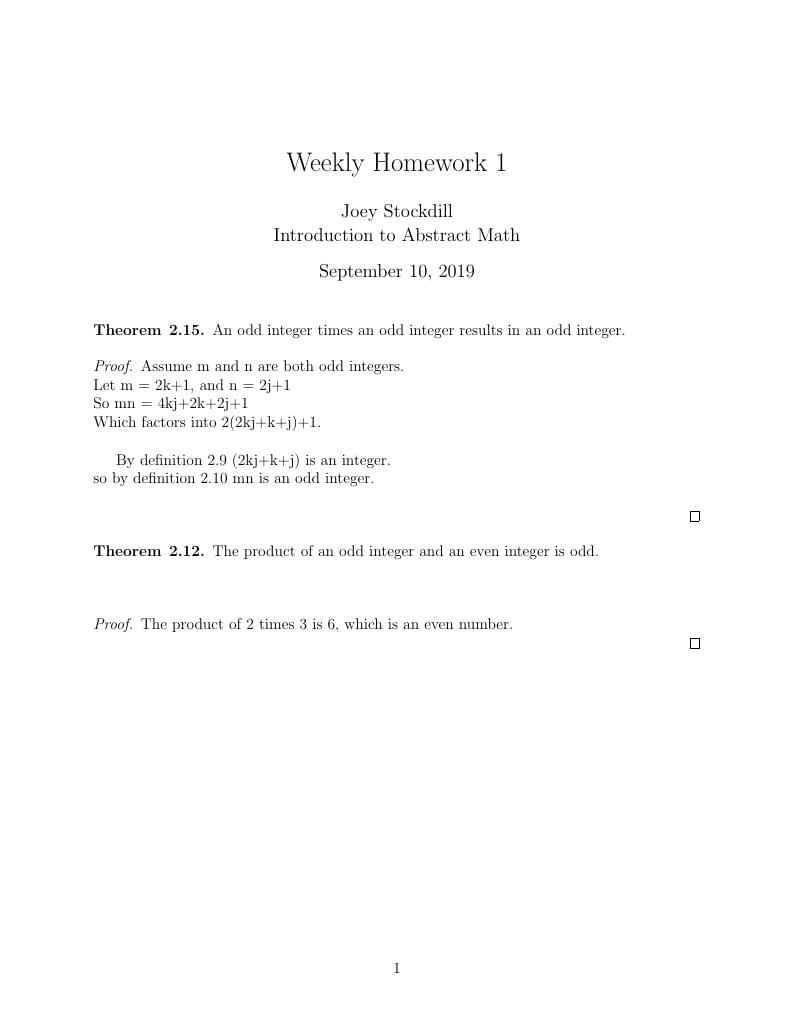
Introduction to Abstract Math Weekly Homework #1
Author:
Joseph Stockdill
Last Updated:
před 6 lety
License:
Creative Commons CC BY 4.0
Abstract:
weekly homework

\begin
Discover why over 20 million people worldwide trust Overleaf with their work.
weekly homework

\begin
Discover why over 20 million people worldwide trust Overleaf with their work.
% --------------------------------------------------------------
% This is all preamble stuff that you don't have to worry about.
% Head down to where it says "Start here"
% --------------------------------------------------------------
\documentclass[12pt]{article}
\usepackage[margin=1in]{geometry}
\usepackage{amsmath,amsthm,amssymb}
\newcommand{\N}{\mathbb{N}}
\newcommand{\Z}{\mathbb{Z}}
\newenvironment{theorem}[2][Theorem]{\begin{trivlist}
\item[\hskip \labelsep {\bfseries #1}\hskip \labelsep {\bfseries #2.}]}{\end{trivlist}}
\newenvironment{lemma}[2][Lemma]{\begin{trivlist}
\item[\hskip \labelsep {\bfseries #1}\hskip \labelsep {\bfseries #2.}]}{\end{trivlist}}
\newenvironment{exercise}[2][Exercise]{\begin{trivlist}
\item[\hskip \labelsep {\bfseries #1}\hskip \labelsep {\bfseries #2.}]}{\end{trivlist}}
\newenvironment{problem}[2][Problem]{\begin{trivlist}
\item[\hskip \labelsep {\bfseries #1}\hskip \labelsep {\bfseries #2.}]}{\end{trivlist}}
\newenvironment{question}[2][Question]{\begin{trivlist}
\item[\hskip \labelsep {\bfseries #1}\hskip \labelsep {\bfseries #2.}]}{\end{trivlist}}
\newenvironment{corollary}[2][Corollary]{\begin{trivlist}
\item[\hskip \labelsep {\bfseries #1}\hskip \labelsep {\bfseries #2.}]}{\end{trivlist}}
\newenvironment{solution}{\begin{proof}[Solution]}{\end{proof}}
\begin{document}
% --------------------------------------------------------------
% Start here
% --------------------------------------------------------------
\title{Weekly Homework 1}%replace X with the appropriate number
\author{Joey Stockdill\\ %replace with your name
Introduction to Abstract Math} %if necessary, replace with your course title
\maketitle
\begin{theorem}{2.15} %You can use theorem, exercise, problem, or question here. Modify x.yz to be whatever number you are proving
An odd integer times an odd integer results in an odd integer.
\end{theorem}
\begin{proof} %You can also use solution in place of proof.
Assume m and n are both odd integers.\\
Let m = 2k+1, and n = 2j+1\\
So mn = 4kj+2k+2j+1\\
Which factors into 2(2kj+k+j)+1.\\
%Note 1: The * tells LaTeX not to number the lines. If you remove the *, be sure to remove it below, too.
%Note 2: Inside the align environment, you do not want to use $-signs. The reason for this is that this is already a math environment. This is why we have to include \text{} around any text inside the align environment.
By definition 2.9 (2kj+k+j) is an integer.\\
so by definition 2.10 mn is an odd integer.\\\\
\end{proof}
\begin{theorem}{2.12} %You can use theorem, exercise, problem, or question here. Modify x.yz to be whatever number you are proving
The product of an odd integer and an even integer is odd.\\\\
\end{theorem}
\begin{proof} %You can also use solution in place of proof.
The product of 2 times 3 is 6, which is an even number.
\end{proof}
% --------------------------------------------------------------
% You don't have to mess with anything below this line.
% --------------------------------------------------------------
\end{document}